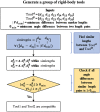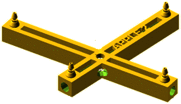Design and validation of an open-source library of dynamic reference frames for research and education in optical tracking
- PMID: 29487887
- PMCID: PMC5806031
- DOI: 10.1117/1.JMI.5.2.021215
Design and validation of an open-source library of dynamic reference frames for research and education in optical tracking
Abstract
Dynamic reference frames (DRFs) are a common component of modern surgical tracking systems; however, the limited number of commercially available DRFs poses a constraint in developing systems, especially for research and education. This work presents the design and validation of a large, open-source library of DRFs compatible with passive, single-face tracking systems, such as Polaris stereoscopic infrared trackers (NDI, Waterloo, Ontario). An algorithm was developed to create new DRF designs consistent with intra- and intertool design constraints and convert to computer-aided design (CAD) files suitable for three-dimensional printing. A library of 10 such groups, each with 6 to 10 DRFs, was produced and tracking performance was validated in comparison to a standard commercially available reference, including pivot calibration, fiducial registration error (FRE), and target registration error (TRE). Pivot tests showed calibration error [Formula: see text], indistinguishable from the reference. FRE was [Formula: see text], and TRE in a CT head phantom was [Formula: see text], both equivalent to the reference. The library of DRFs offers a useful resource for surgical navigation research and could be extended to other tracking systems and alternative design constraints.
Keywords: dynamic reference frames; open-source; optical tracking; surgical navigation; three-dimensional printing.
Figures









Similar articles
-
Accuracy assessment for the co-registration between optical and VIVE head-mounted display tracking.Int J Comput Assist Radiol Surg. 2019 Jul;14(7):1207-1215. doi: 10.1007/s11548-019-01992-4. Epub 2019 May 8. Int J Comput Assist Radiol Surg. 2019. PMID: 31069642
-
Probe versus microscope: a comparison of different methods for image-to-patient registration.Int J Comput Assist Radiol Surg. 2018 Oct;13(10):1539-1548. doi: 10.1007/s11548-018-1800-0. Epub 2018 Jun 5. Int J Comput Assist Radiol Surg. 2018. PMID: 29869745 Free PMC article.
-
Estimating FLEimage distributions of manual fiducial localization in CT images.Int J Comput Assist Radiol Surg. 2016 Jun;11(6):1043-9. doi: 10.1007/s11548-016-1389-0. Epub 2016 Mar 30. Int J Comput Assist Radiol Surg. 2016. PMID: 27025605 Free PMC article.
-
Assessment of optical localizer accuracy for computer aided surgery systems.Comput Aided Surg. 2010;15(1-3):1-12. doi: 10.3109/10929081003647239. Comput Aided Surg. 2010. PMID: 20233129
-
Current state in tracking and robotic navigation systems for application in endovascular aortic aneurysm repair.J Vasc Surg. 2015 Jan;61(1):256-64. doi: 10.1016/j.jvs.2014.08.069. Epub 2014 Oct 14. J Vasc Surg. 2015. PMID: 25441011 Review.
Cited by
-
Role of Reference Frames for a Safe Human-Robot Interaction.Sensors (Basel). 2023 Jun 20;23(12):5762. doi: 10.3390/s23125762. Sensors (Basel). 2023. PMID: 37420924 Free PMC article.
-
Vaginal Cuff Closure with Dual-Arm Robot and Near-Infrared Fluorescent Sutures.IEEE Trans Med Robot Bionics. 2021 Aug;3(3):762-772. doi: 10.1109/tmrb.2021.3097415. Epub 2021 Jul 15. IEEE Trans Med Robot Bionics. 2021. PMID: 36970042 Free PMC article.
-
Real-time surgical instrument tracking in robot-assisted surgery using multi-domain convolutional neural network.Healthc Technol Lett. 2019 Dec 5;6(6):159-164. doi: 10.1049/htl.2019.0068. eCollection 2019 Dec. Healthc Technol Lett. 2019. PMID: 32038850 Free PMC article.
-
Design, construction, and deployment of a multi-locus transcranial magnetic stimulation system for clinical use.Biomed Eng Online. 2025 May 18;24(1):61. doi: 10.1186/s12938-025-01393-6. Biomed Eng Online. 2025. PMID: 40383760 Free PMC article.
-
FLEX: FLexible Transducer With External Tracking for Ultrasound Imaging With Patient-Specific Geometry Estimation.IEEE Trans Biomed Eng. 2024 Apr;71(4):1298-1307. doi: 10.1109/TBME.2023.3333216. Epub 2024 Mar 20. IEEE Trans Biomed Eng. 2024. PMID: 38048239 Free PMC article.
References
-
- Tendick F., et al. , “A virtual environment testbed for training laparoscopic surgical skills,” Presence Teleoperators Virtual Environ. 9(3), 236–255 (2000).10.1162/105474600566772 - DOI
LinkOut - more resources
Full Text Sources
Other Literature Sources
Miscellaneous

